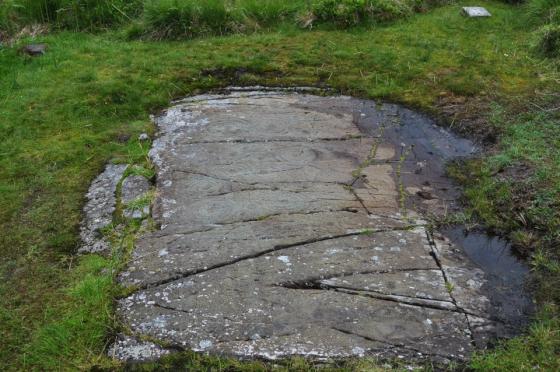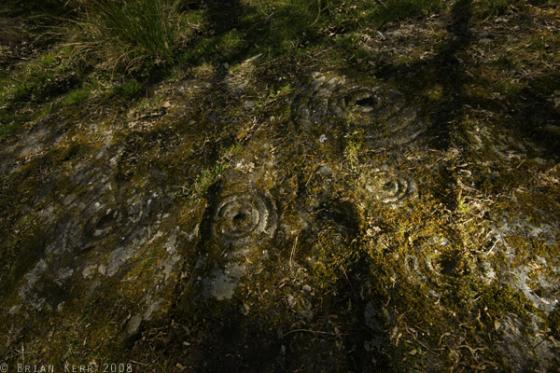
The fort is difficult to find, find this wee waterfall and pool on the north side of the bridge, then head east into the undergrowth.

The fort is difficult to find, find this wee waterfall and pool on the north side of the bridge, then head east into the undergrowth.

South east defence.

Looking to east, point of the promontory. if you manage to jump a half mile you’ll land in the Crinan Canal.

The branch points out the ditch to the north west, where if fades into the northern slope.

The weird building in the middle of the fort.

The burn at the bottom of the slope on the south side.

The ditch on the west.

After driving from Turriff, a wee stone circle and a hunt looking for the fort, refreshment needed at the pub to left The Grey Gull. The fort is the high point in the middle.
From our accommodation in Ardrishaig we headed down to the Crinan Canal and walked north along West Bank Road until to come to the Kilduskland Burn. Follow the path west, climbing steadily, cross two wooden bridges looking for a small waterfall near a reasonably sized pool. The fort is on the northern side, then head east.
Sadly vegetation has taken over much of the fort. Outer defences are reached or tripped over on the west side. Both sides of the fort are protected by sheer drops falling into two steams. Buildings in the fort are almost impossible to make out but are there.
A winter time visit needed to really see what’s going on here. Still a very nice, cool walk amongst the trees after a long car journey. Even better a pub on the shore at the bottom of the hill.
Visited 23/07/2021.
Sometime before 1490 (maybe even centuries before!) a young lad named McVicar was tending to his mother’s cow near Brenfield on the shore of Loch Fyne. A party of cattle-raiders passed by, and he spied on them, taking note of where they were heading. According to one story, the raiders were MacAllisters from Tarbert, while another version says they were MacNeills from the Isles. The old maps record them as Campbells. Whoever they were, they had been stealing cattle from the MacIvers of Glassary, who were kinsmen of the lad’s mother. He lost no time in running home and raising the alarm.
The MacIvers were known as the ‘Shaggy Black Horses of Glassary’, and they weren’t best pleased. Cattle raiding was rife between clans, and besides the insult to their pride, the loss of livestock inflicted hardship and starvation on families. Quickly gathering a band of vengeful warriors, they galloped off in pursuit, with the young lad as their guide. They were armed to the teeth, and they’d also had the forethought to bring along the ’wise woman’ of the clan, a witch whose powerful sorcery was only effective while she was mounted on horseback.
They followed the raiders’ tracks through Stronachullin and along the old drove-road over Sliabh Gaoil; then they headed south-west, skirting low rocky hills and isolated lochans until they caught sight of their quarry at a little place named Carse, where the Learg an Uinnsinn river empties into Loch Stornoway. Here they fell on the cattle raiders with unbridled fury. In the heat of the battle, the MacNeills (or MacAllisters, or Campbells!) recognised the witch and yanked her rudely from the saddle. Panick-stricken, the MacIvers yelled, ‘Cur a’Chailleach air a capull!’ (‘Get the old one back onto her mare!’)
But it seemed that the wise woman had other ideas. Perhaps she sensed imminent defeat, or maybe she’d had enough of being used as a battle-witch! Leaping back onto her horse, she galloped away from the mayhem and fled westwards, halting atop a rocky knoll with sweeping views southwards towards the Sound of Gigha. Here, with the sea yawning below her, she leapt and was gone…
Meanwhile, down on the shore, the MacIvers knew that fortune had deserted them but they were fighting grimly on. By this time, other people had got involved: an onlooker, a MacNab, was pursued by four attackers and only saved himself by leaping across a gorge. At least one head had been lost, because the victors later proudly washed it in a river pool known as Slochd na Cinn, ‘the Pool of the Head’.
The young McVicar lad escaped with his life, but it was said that he became an outcast, living in an old fort known as the ‘robber’s den’ above Ardrishaig. He was a menace to his neighbours so one night his thatch was set alight and he was killed while trying to escape. Meanwhile, in a place where the calls of oystercatchers and curlews float up from the ebbing tide, the MacIver clansmen were buried. Standing stones were said to mark their graves.
Miss Marion Campbell of Kilberry
‘The Kist’, the Magazine of the Natural History and Antiquarian Society of Mid-Argyll 1974






























































































































































